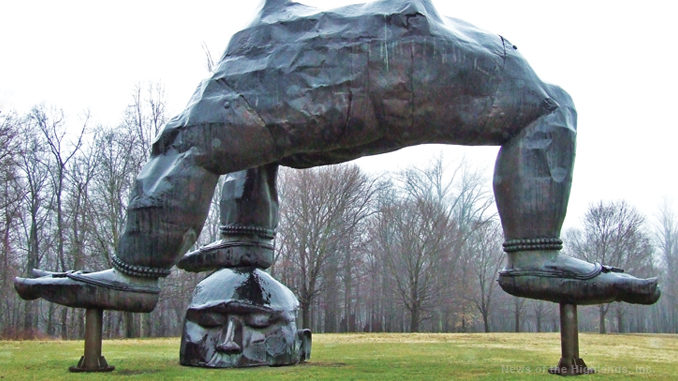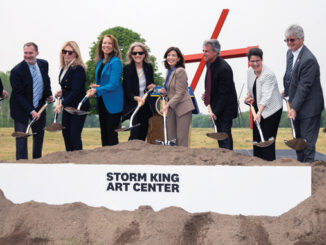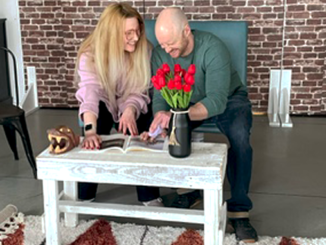
Storm King Art Center is celebrating its 60th anniversary this year. The center, dedicated to exhibiting contemporary and modern art, focusing on large-scale sculpture, is a popular tourist attraction, drawing 180,000 visitors in the past year. Home to over 100 sculptures, the museum and surrounding acreage was actually started by a man who had little knowledge of art.
“In the beginning, my grandfather didn’t know a lot about art,” said Storm King Art Center president John Stern. “He wasn’t really a collector. In some ways I think it’s amazing he just started an art center.”
History
In 1929, after the stock market crash, Ralph “Ted” Ogden moved to Mountainville, with his wife and 5-year-old daughter, into the home purchased by his father 18 years prior.
Ogden eventually became friends with Vermont Hatch, a banking specialist who, in 1935, built a two-story Normandy-style chateau off what is now known as Old Pleasant Hill Road. Built on top of a hill, the stone house overlooked 23 acres of open space.
When Hatch died, in 1959, Ogden purchased the estate with a vision of preserving the property. Ogden was even able to obtain additional property Hatch owned, expanding his holdings to a 200-acre tract.
“It was because of the idea of preserving this building and the hill that we’re on and the views, that my grandfather came up with this idea of having an art center,” said Stern.
At the time, Ogden was also looking to escape the stress of owning a business – the Star Expansion Company. When he retired, his son-in-law, Peter Stern, was brought in to become one of the biggest employers in the Cornwall area.
In July 1960, the Storm King Art Center opened to the public. The former Hatch home was converted into the museum, which still exists today. The rooms were converted into galleries, as well as a visitors’ center. The large windows allow visitors to appreciate the artwork on the inside and outside.
Early on, the museum’s focus was showcasing the work of Hudson Valley painters such as Winslow Homer, who spent two summers in Mountainville, from 1877 to 78, making beautiful paintings of the farmland off what is now Route 32.
A year after opening the museum, Ogden purchased his first sculptures. They were relatively small works. It wasn’t until the end of the 1960s that the vision changed to seeing art and large-scale sculptures outdoors.
Several of those earlier works were made by the sculptor David Smith. When Smith died, Ogden went to visit the man’s home studio in the Adirondacks. The artist had 89 sculptures spread out over 80 acres. A light bulb went on in Ogden’s mind.
“He loved land, but didn’t know a lot about art,” Stern said. “He was interested in building a collection, to share with the public, that worked with land. He loved seeing those outdoor sculptures. That was really the vision from that point on.”
In the fall of 1966 and the spring of 1967, Ogden purchased 13 sculptures, the biggest acquisition of Smith’s work.
When the museum opened, Ogden made his son-in-law an administrator, priming him for a more robust leadership role in the future. Ogden died in 1974.
Landscape
Shortly after opening the museum, Ogden purchased 2,100 acres of land to the east of Schunnemunk Mountain. His vision of the future was to preserve the natural beauty. The land eventually became part of the state park for the purpose of passive recreation.
On a clear day, the art center offers views of Schunnemunk and Storm King Mountains. It’s after the mountain that the museum got its name. In 1850, writer Daniel Parker Lewis proposed the mountain’s name to the Town Board.
In the silence, one can hear the passing of vehicles on the New York State Thruway, which was completed in the 1950s prior to the art center’s opening.
“What’s nice about the experience of discovering art at Storm King, it’s almost like your first observation is about the landscape and then you come up upon the works,” said Stern.
As the vision turned toward outdoor sculpture, Ogden hired landscape architect Bill Rutherford to sculpt the surrounding property and give it a natural feel. Rutherford worked for Ogden for 45 years.
“Bill Rutherford used a lot of reclaimed land, where the New York State Thruway was built,” Stern said. “They left a lot of gravel they didn’t use. A lot of the land near the Thruway had been devastated because of the construction. Rutherford saw it as making lemonade from lemons.”
One of the first projects was to grade the hill upon which the museum sits. Gravel was also used to make new platforms for sculptures.
“He’s the unsung hero to what Storm King has become,” Stern said of Rutherford.
The landscape is just as important to the art center as the sculptures.
The rolling hills seem to create an optical illusion when viewing Menashe Kadishman’s “Suspended” from a distance.
Maya Lin created a site-specific work called “Storm King Waveland.” Repurposing one of the gravel pits, she sculpted the land to create waves. The crests and troughs resemble the Schunnemunk ridgeline.
Andy Goldsmith created “Storm King Wall” using stone fold dilapidated agricultural walls which once existed on the property. The commissioned work hugs the tree line and even protrudes from a pond.
Stern said some artists prefer their work be placed in a particular location. If a tree dies, a work might be re-sited to create the perfect backdrop. Visiting the museum is always a unique experience because sculptures might be relocated or they may look different depending on the day’s weather and the season.
Art Center
Storm King Art Center is opening seasonally, but does conduct winter weekends. The next scheduled winter weekend is March 21 to 22 from 11 a.m. to 4 p.m.
The museum will open April 1 with the exhibition opening scheduled for May 9. The museum is open through early December.
The art center boasts miles of walking paths, as well as hiking trails. Cognizant of those who might have difficulty walking, there is a tram which takes guests around the grounds. Visitors may also rent one of the 65 bicycles made available.
While many come to view the sculptures, the art center offers other programs throughout the year. Yoga sessions are held Saturdays from May through September. Moonlight walks are also popular.
The art center boasts sculptures which are part of its permanent collection. Some pieces are only on loan for a period of time. Curator David Collens may also reach out to artists, or vice versa, about commissioning site-specific works.
Part of the art center’s mission is to support artists. In the last few years, the center has hosted an artist in residence. Between June and September, about 15 artists come to Storm King, for a few weeks, to think about what they want to do next in their careers. The artists stay in a house on the property located to the south.
Anniversary
For the museum’s 50th anniversary celebration Zhang Huan’s “Three Legged Buddha was installed as part of the permanent collection. What is being planned this year is still unknown, but an itinerary of events is nearing completion.



